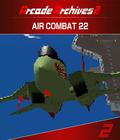There's a good chance that you might not have ever played Air Combat or its sequel, Air Combat 22. Unless you frequented an arcade often in the mid-1990s and weren't making a beeline straight to the fighting games, none of these titles ever made their way to the PC or home consoles. The version of Air Combat that showed up on the original PlayStation was made specifically for the home rather than the arcade. The arrival of Arcade Archives 2: Air Combat 22 serves as the first official way to experience one of the titles that added fuel to the 3D fight between Namco and Sega and eventually influenced the whole Ace Combat series.
If you've played any of the Ace Combat games and are looking for a story, forget about it. The game tries to have some dialogue playing in the brief cut scenes, but it's difficult to hear over the blaring soundtrack. All you can make out are general status reports about the mission. This really is an arcade experience where you need to worry about the action and nothing else.
As the title would imply, Air Combat 22 is a shooting game, but it doesn't quite follow the formula set about by titles like After Burner. Instead of constantly going forward and shooting planes that come your way, you have a full 360 degrees of movement and are engaged in dogfights against other planes. The objective is to down every enemy plane in the area before time expires, but there will be moments when the objectives will change, such as when you attack a battleship or have to dock your plane midair for refueling. Your arsenal of weapons is basic, as you have homing missiles and a Vulcan machine gun. You don't have to worry about enemies attacking you, but you will have to be aware of countermeasures against your missiles, such as chaff being deployed. Aside from that, your only other enemy is time; you have a short amount of time to destroy all of the planes in the area before you can move on to the next area.
For an arcade game, there's a bit of depth but not much compared to where the series would eventually go, gameplay-wise. Aside from full 360-degree control, you can also control your speed, which is essential because enemies will often try to zoom at you before making sharp banks to avoid fire. Your ammo is limited, which means a lot for your missiles, since you never seem to have enough in your arsenal. Your machine gun is a different story, as you have a ton of bullets unless you go through every stage while holding down the fire button. You have three planes to choose from, the Grumman F-14 Tomcat, Sukhoi Su-27 and the Lockheed Martin F-22 Raptor, but with the proper names hidden to avoid paying for the licenses. All three aircraft perform the same, so the choice is down to aesthetics. You also have three different viewpoints to choose from, with one of them being an in-cockpit view.
The simple approach has something for the score chasers: an explanation of the scoring system. You get points for blowing up planes, but you get more points if you do so with your machine gun. This creates an interesting scenario where you need to balance your approach to get the highest possible score without pumping in a load of virtual quarters to extend your time. Using the machine gun gets you the most points per kill, but the chase and bullets eat up some of that precious time. Using missiles nets faster kills, even if some of those missiles hit enemy chaff. You'll get fewer points, but you won't risk losing time. It's an interesting balancing act that you may not realize is there until you spend time experimenting with the game.
When it comes to the game's length, it is very short compared to most other arcade games of any era. Give it an average of 15 minutes, and you'll reach the end of the campaign. With that said, the game gives you several ways to expand the experience beyond one campaign run. Play the game in the Cadet (with tutorial) difficulty, and you'll play through five different levels in a linear fashion. The mode is great if you want a quick session, but the appearance of each tutorial during inopportune times breaks up the rhythm. Choose the regular Cadet difficulty, and things change drastically because you'll get to play in different levels, depending on how you finish the first stage. The key for the path branching only involves your final elevation height when finishing that first stage, but it gives you an excuse to do another playthrough if you want to see everything.
Top Gun difficulty amplifies the branching and level variety by having the branches occur on the first and second levels, depending on how many aircraft you shoot down with your Vulcan. On top of that, the stage count is expanded by one. Finally, there's Dogfight, which pits you against enemy planes one at a time with four planes per stage over 32 levels. Another element that makes this different from other modes is the lack of a continue function, giving the mode some real legs because you can't brute-force your way through it.
The presence of four different difficulty levels and scenarios doesn't take into account the various modes that Hamster has always included in all of its Arcade Archives releases. Hi Score mode has you trying to get the highest score possible on just one credit. Caravan mode has you playing the game for five minutes to see how high of a score you can rack up. Time Attack mode is essentially the original arcade mode, but scores are determined by how quickly you can finish the game. All three modes come with their own leaderboards, and those leaderboards are separated by the chosen difficulty mode. The only exception is the leaderboard for Caravan mode, as that mode only has you playing Dogfight.
Considering how old the game is, especially for an early polygon-based title, the presentation holds up quite well. Graphically, the texture work is fine. Don't expect a ton of minor details, but what you're getting doesn't look very low resolution, either. The ground textures might show their age a bit, but that's mostly because it's an element few people are expected to look at. The brighter colors help balance things out, as does the sharpening of the polygons throughout. The 60fps on display keeps things looking nice. When it comes to the controls, they're a good translation from the throttle and flight stick the arcade featured. Switch/Switch 2 owners (and presumably PS4/PS5 owners) have the benefit of gyro controls, so those who love motion controls will be happy about that.
The audio is the one area that hasn't aged all that well. As mentioned earlier, the sound balancing is bad enough that you'll barely be able to make out any of the radio calls due to the rock music blaring at all times. That music is fine, but it doesn't do a great job of getting you amped up for a dogfight like other arcade jet fighting games, especially since none of the tracks will get stuck in your head after you're done playing. The sound effects are good enough, but that's really about it.
You'll have a good experience with Arcade Archives 2: Ace Combat 22, provided you know what you're getting into. The gameplay loop is quite simple, and the experience seems short, at least initially, which might make it a tough sell for more casual players. When you start diving into the game mechanics and the various difficulty levels (and inherent differences), you'll find a title that appeals to both high score-chasers and completionists due to the various possible campaign paths. Those looking to add to their current arcade collection will find this game to be a great addition to that library, especially since it never received a home port before. Everyone else will find a game that has a surprising amount of depth, despite its quarter-munching roots.
Score: 8.0/10
More articles about Arcade Archives 2: Air Combat 22











 Air Combat 22 is a flight shooter released by NAMCO (Bandai Namco Entertainment) in 1995, featuring an evolutionary step in 3D graphics and flashy animations using the "System Super 22" arcade board.
Air Combat 22 is a flight shooter released by NAMCO (Bandai Namco Entertainment) in 1995, featuring an evolutionary step in 3D graphics and flashy animations using the "System Super 22" arcade board.





